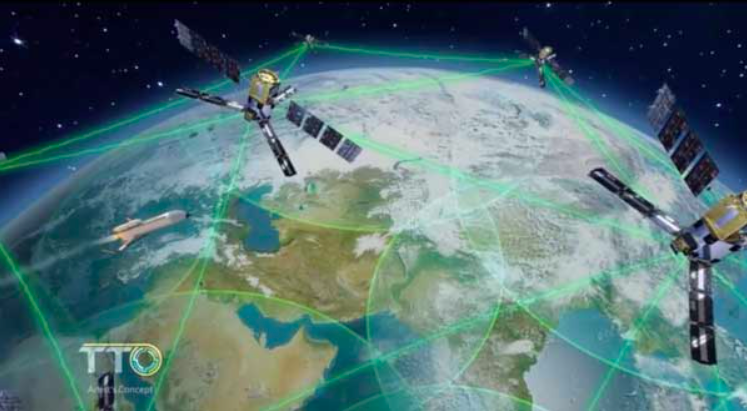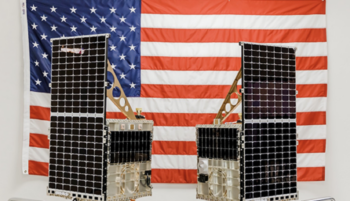
Blackjack concept, (DARPA Tactical Technology Office image)
WASHINGTON — Fresh from a successful test of a space-to-space laser link for intersatellite communications, DARPA’s pair of Mandrake 2 experimental satellites will next attempt to use light beams to relay data from space to the ground, DARPA’s Stephen Forbes told Breaking Defense in an interview on Tuesday.
Forbes manages DARPA’s Blackjack project to demonstrate how the Defense Department can scale up large constellations of small, interlinked satellites in Low Earth Orbit (LEO) for multiple missions. Mandrake is designed to “burn down risk as quickly as possible” for low-cost optical intersatellite links (OISLs) for those kinds of constellations, including those being developed by the Space Development Agency (SDA), he explained.
“Mandrake 2 is a risk reduction for the Blackjack and the proliferated LEO programs. Which is why SBA partnered with us — why this coalition of the willing came together — because to build that proliferated LEO architecture, we need to be able to share data across the satellites,” he said. “That fundamentally is foundational to what these architectures need to be successful.”
Derek Tournear, SDA director, has stressed that OISLs are a key enabler for the Transport Layer of the agency’s seven-layered National Defense Space Architecture. The Transport Layer is the planned constellation of LEO satellites, deemed by DoD as the “backbone” SATCOM infrastructure for DoD’s emerging Joint All Domain Command and Control network of networks.
And Forbes is extremely pleased with Mandrake 2’s first demonstration, which in May was able to use OSILs to transmit “around 280GB of data” between themselves “at a 114km range in a period exceeding 40 minutes,” according to a June press release from prime contractor SEAKR Engineering, a subsidiary of Raytheon Technologies.
Astro Digital built the buses for the Mandrake 2 satellites, which were launched last June by SpaceX. Advanced Solutions wrote the flight software and is supporting mission operations; Maverick Space Systems performed integration and test analysis, as well as launch integration services; and Lockheed Martin provided integration support and launch procurement, according to DARPA’s website. Finally, SA Photonics developed the OISL hardware.
Beyond demonstrating the capability of OSILs, Forbes said a key aspect of the demonstration for the Pentagon is that the laser communications terminals onboard the satellites are much smaller and cheaper than any previously demonstrated, allowing DoD to “scale up” to widespread operational use.
“It hasn’t really been done at this price point before,” he said. “We’re talking about terminals that are on the order of 10 kilograms, or 50 watts of power, so little tiny things compared to the previous terminals [demonstrated by NASA and the European Space Agency]. And at a price point, that is probably an order of magnitude less,” he said, costing “a couple hundred thousand dollars apiece.”

DARPA’s two Mandrake 2 satellites. (Credit: Astro Digital/DARPA.)
Up (And Down) Next: Space-to-Ground Links
But DARPA has broader ambitions for OSIL technology, Forbes said. “We wanted to do both space-to-space and space-to-ground.”
There are different technical challenges for those two use cases, he explained. Longer ranges are involved when beaming down to ground receivers from a satellite — satellites in LEO operate at anywhere from around 300 kilometers in altitude to 2,000 — meaning a stronger laser is required. Complications also arise because of the need to keep the beam focused on the ground site as the satellite passes over it, remembering its path will change slightly with each pass because the Earth is rotating.
Further, the beam has to traverse the atmosphere, which attenuates it. Thus, adaptive optics — a method of keeping the laser beam narrow using reformable mirrors — are required. And the problems become worse if there is rain or bad weather that can distort the beam. Indeed, optical communications simply become impossible if the clouds are thick enough.
“All of that is essentially trying to shake that soda straw [i.e. the laser beam],” Forbes said. “And now you are in longer ranges, so the pointing [towards a target receiver] is even harder.”
Forbes said that DARPA hopes to undertake a space-to-ground communications test soon.
“We’re probably looking at a month or so. But, you know, it’s the first time. So, it’s really hard to predict,” he said.
“Of course, we all thought that we were going to have our first space- to-space link at a month or a month-and-a-half on orbit and it was like 10 months later, or whatever it was, before we finally got it to work,” he added with a self-deprecating laugh.
However, Forbes wouldn’t be drawn on when the first Blackjack satellite would launch.
“We continue to make progress towards our first launch. I think that’s all really I want to say about Blackjack right now,” he said.




















